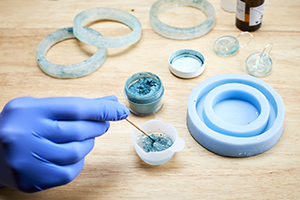
Making jewellery with resin is an incredibly exciting and fun way to get creative. If you’re just starting your resin jewellery making journey then it is important to at first, understand the basics and practice before you start making. Here at Cooksongold we think resin is a fantastic product to use when making jewellery which is why we have developed our resin jewellery hub to provide you with guidance, tips and more.
Just starting your journey? We’ve supplied the answers for some of the most common questions that beginners ask when first working with resin…
Resin FAQs
- Is resin dangerous?
Although resin isn’t toxic, it is categorized as hazardous goods. Resin works by creating a chemical reaction and therefore is classed as being as dangerous as other household chemicals and must be handled carefully. Taking safety precautions such as ensuring you wear safety gloves, eye protection and an apron when mixing resin is important. Resin must not be inhaled or swallowed.
- Do I need a mould to make resin?
Moulds are not essential when making resin jewellery. For beginners in particular, using blanks and settings are a great starting point. Why? To put it simply blanks are easier to work with. You only have to worry about the top part of your resin, no filing or sanding will be required and you can scoop out and start again if your resin fails to cure. Moulds are versatile but it is a lot easier to create a finished piece when using a setting.
- How do I mix resin correctly?
It is important to measure resin correctly. The mix ratio of epoxy resin and hardener is 2:1 this means, by volume you will require two parts of your resin and one part hardener. Not measuring correctly may cause your resin to fail to cure so be sure to use a measuring jug for accuracy.
- Why are there bubbles in my resin?
Unfortunately when working with resin, you may find that your piece has bubbles. Bubbles can be caused by a range of issues, which includes not sealing photographs, the temperature of your resin and overmixing, amongst others. Bubbles can be removed by carefully using a toothpick to pop the bubbles or a straw to gentley blow the bubbles out. If there are too many bubbles you may need to repour but practice makes perfect so don’t give up!
- Why is my resin cloudy?
Cloudy resin is often caused by using the wrong mould. In order to make shiny resin you will need to use a specialist resin mould that has a shiny cavity as only this will ensure that your piece is shiny when you remove it.
- How does resin harden?
The process through which epoxy resin goes from a liquid into a solid is referred to as curing. This is done by mixing your resin correctly with hardener. With the correct ratio, your resin should cure within 24 hours.
- Why is my resin not hard?
Resin takes approximately 24 hours to cure. If your resin, after the recommended time, has not yet hardened then there could be a number of reasons for this. Incorrect room temperature, inaccurate measurement, imporper mixing, contamination and poor quality mould are just some of the reasons why resin does not harden. Consider what could be the possible reason for your resin to remain sticky? Whatever you do, don’t give up!
- Can I add anything to resin
You can set almost anything in resin. From shells to flowers to glitter, fabric, clay, puzzle pieces, watch parts, special momentos and more. You may need to seal your items but generally, as long as what you want to set it dry, it should work well.
- What does sealing mean?
Sealing applies mostly to items that may soak in the resin or cause air bubbles. Resin can easily seep into paper, fabric, wood and other porous materials which is why it is advised to seal with a clear sealant (PVA glue can work well). Applying this seal will provide a barrier and ensure a better result when setting in resin.
- Is it easier to make resin jewellery in a setting?
It can be a lot easier to set resin in a jewellery blank or setting. This is because you will only really have to worry about the top of the resin, your piece won’t need to be demoulded and as a result there won’t be any need to file or sand your piece. Making resin jewellery using a setting or blanks is a great starting point for beginners.
Ready to get started on your jewellery making journey? Let the team at Cooksongold help. Visit our dedicated resin jewellery making area for all of the help you’ll need along the way.


Cooksongold
